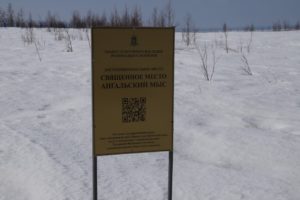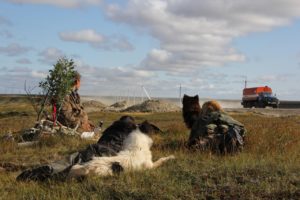This contribution takes a longue durée perspective of 20 years to the transformation of spiritual ways of knowing the land. The ways in which Nenets people in the Russian Arctic display or hide their relations with the spirits from incomers have changed over time, due to a number of outside influences, but also to relations of trust between the author and the practitioners in the field.
The Nenets have a very vital culture of nomadic mobility with large herds of domestic reindeer in the Arctic tundra, with migration routes reaching up to 1,200 km yearly on reindeer sledges. The landscape is inhabited by the spirits of the ancestors, with spiritual energy concentrated at stationary sacred sites on the one hand, but also mobile sanctuaries in sledges (Skvirskaya 2005) that travel with most nomadic households on their migration routes, pulled by specially selected sacred reindeer.
When I started working with Nenets reindeer nomads as an undergraduate student, the spiritual world was completely alien to me, and I understood that Nenets culture is incredibly rich in religiously inspired taboos that influence everyday life in the tundra. Many of the taboos relate to women and their spiritual power during menstruation, but others are also connected to men, e.g. the spiritual power of the male belt that is not supposed to lie on the ground, the energy of the land that should not be stabbed with a knife, or the spiritual energy of the different poles of the chum (conical nomadic tent). These elaborate spiritual everyday rules made me understand that Nenets religion is incredibly complex and taboo-loaded and that it is dangerous for a young student to delve with questions into any details. So, I left the topic of spirituality and religion out of my initial research as much as possible.
Then, in the early 21st century, gas and oil extraction activities increasingly encroached Nenets pastures and also started threatening several sacred sites. In a seminal work commissioned by CAFF, Nenets ethnographer Galina Khariutschi first mapped sacred sites in a publication (CAFF 2004, Khariutschi 2006), and the regional authorities started registering them as official cultural monuments (see fig 1).
Figure 1: officially registered sacred site close to Salekhard, Yamal-Nenets Autonomous Okrug, West Siberia.
During my subsequent yearly returns to the tundra to the tundra, I noticed that gradually my reindeer herding friends opened up to me on the spiritual topic and introduced me to their spiritual world on their own initiative, without me even asking for it.
In this contribution I shall describe several key events that contributed to my understanding of this world. I shall then discuss how the motivations for this increased openness by my Nenets friends can be explained. The first event was when I brought first my daughter to live with me for a short time with the Khudi family in spring in the forest tundra, close to the ancient Stalin railroad 501, which was being revived as a road connecting the two principal towns in the region. We would sit in the chum in the evening and my hosts Yuri and Evgenii would talk to me about how the spirits of the dead would appear now on this old railroad corridor where the road construction started. When the herders cross the road on sledges, they would see the spirits, with mixed feelings of fear and helplessness. A sacred tree close by the road corridor continues to serve as a site for worshiping the spirits and share experiences with them.
The second event was a year later when we crossed the Bovanenkovo gas deposit with the same reindeer herders camp, in summer. After having crossed with the herd the Se-Yakha river, Yuri and Evgeni said we need to slaughter a reindeer for thanking the spirits for the safe crossing, and feed the sacred site that oversees the river from the northern side. Sitting with the men and boys at the site (women are not admitted for spiritual taboo reasons), I found out that the herders saved the sacred site from destruction when the gas company built a maintenance road. The herders had gone public and mobilized their political representatives to safeguard their sacred site, and the gas company agreed to make a detour for the road. While Evgenii says the road loop still goes too close to the site, at least it was not destroyed completely by the industrial infrastructure. Sitting at the sacred site, we noticed a bird circling above us and constantly singing. The Khudi brothers saw this immediately as a good sign. When a gas company truck passed by the road, the driver saw us at the sacred site and stopped. (photo 2).
Figure 2: Evgenii and his son watching the gas truck passing by as they sit at the sacred site close to the Bovanenkovo Gas deposit, Yamal-Nenets Autonomous Okrug, West Siberia.
Spontaneously Evgenii invited him to join. Saying “we thank the spirits of the land and river here. If you want, bring something along and express your gratitude too.” The driver went to his truck cabin and got some cigarettes and candies to offer to the sacred site, and joined an informal conversation. Evgenii gave him a short introduction what the spirits in this place are about and how they saved the site from destruction by the road. He told the driver to tell his colleagues that they could also stop there and express their gratitude. In this way Nenets spirituality crossed ethnic boundaries and entered in to the lives of Ukrainian and Russian gas industry workers.
The third event was recently when the pandemic started in March 2020 and ended up in the chum of another friend of the Khudi family, Tokcha Parivich, whom I had visited the last time 20 years ago. I ended up sleeping in the chum next to the two sacred spiritual figures who guard the hearth and the camp: Myad Pukhutse and Ngo. This was the first time that they were so openly displayed in the chum, while usually the family hides their spiritual figures upon the arrivals of guests.
Later when writing up my field diary about this event, I realized what a significant turn this was from my Nenets friends: from the situation more than 20 years ago when everything spiritual was hidden and I was told only to observe the taboos without knowing any of the background. And now how openly people talked to me about the spiritual sphere by their own initiative and even invited completely alien industry workers to join worshiping! What happened? On the one hand, certainly the decade-long friendship and trust developed between myself as a returning researcher and the reindeer herders as my hosts played a role in this turn towards openness. Repeated returns from the field are known to be crucial in anthropological research especially when it comes to insights into intimate spiritual spheres (Vitebsky 2012). On the other hand, the increased contacts between the world of the reindeer nomads and the world of industry, urbanization and infrastructure may have led to people realizing that their sites become more and more endangered if they will not display agency for their conservation.
On the other hand, one could argue that in a religion with mobile sanctuaries in sacred sledges, how important are stationary sites in the first place? Vitebsky (2005) has argued for the Eveny that any site on the nomadic migration route has spiritual energy that can be woken up when the herders pitch a camp there. However, Yuri and Evgenii’s mother told me impressively that the sacred figures that protect the members of the household in the sacred sledge on the migration need to visit a powerful sacred site from time to time. It is as if with the years their spiritual energy diminishes and needs a re-charge on the sacred site. She says that her husband used to travel all the way to the northern shore at the Malygin Strait to bring sacred figures there from his sacred sledge, and take from there other figures with powerful spiritual energy. So, what to do when sacred sites won’t be there to re-charge the mobile spiritual figures?
My Nenets friends keep emphasising how they feel insecure how to best behave with the spirits. The reason is that the shamans as principal figures to mediate between the human and the spiritual world were almost all prosecuted during the Soviet Union. Many of them took their spiritual knowledge with them before they could pass it on to someone. We have argued that this spiritual insecurity has also led to the rise of conspiracy theories relating to recent disasters that came upon Nenets nomads (Stammler & Ivanova 2020).
References
Stammler, Florian M., and Aytalina Ivanova. 2020. ‘From Spirits to Conspiracy? Nomadic Perceptions of Climate Change, Pandemics and Disease’. Anthropology Today 36(4):8–12. doi: 10.1111/1467-8322.12589.
Khariutschi, G. P. 2006. ‘K Voprosu o Klassifikatsii Sviachennykh Mest Nentsev’. Pp. 50–63 in Yamal-Region: istoricheskaia retrospektiva i sovremennost, edited by V. P. Timoshenko. Salekhard, Ekaterinburg: Bank kul’turnoi informatsii.
CAFF 2004. ‘The Conservation Value of Sacred Sites of Indigenous Peoples in the Arctic: A Case Study in Northern Russia’. CAFF Technical Report No. 11.
Skvirskaya, Vera 2005 ‘New Economic Forms and Social Imaginary in Post-Socialist Russia: … Yamal Region, Siberia’, unpublished PhD thesis, Cambridge, Anthropology
Vitebsky, P. 2005. Reindeer People. Living with Animals and Spirits in Siberia. London: Harper Collins.
Vitebsky, Piers. 2012. ‘Repeated Returns and Special Friends: From Mythic Encounter to Shared History’. Pp. 180–202 in Returns to the field: multitemporal research and contemporary anthropology, ed by Signe Howell, Aud Talle. Bloomington, Indianapolis: Indiana University Press.

